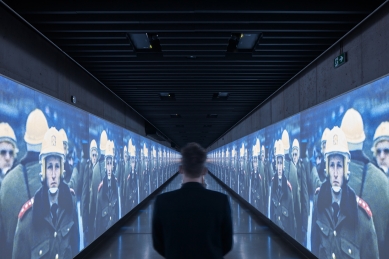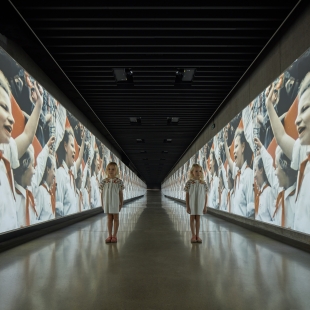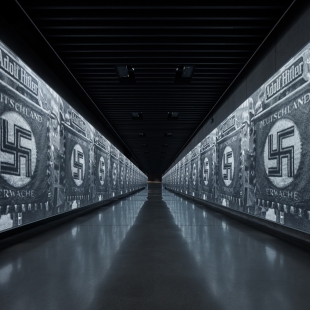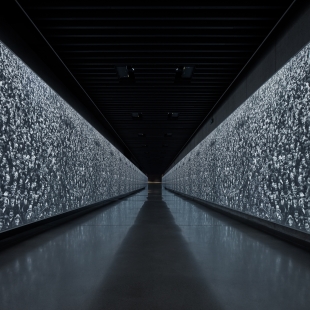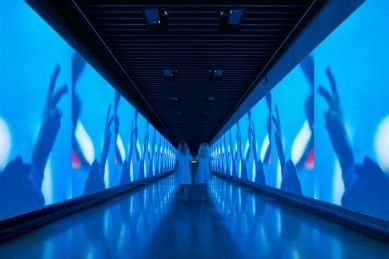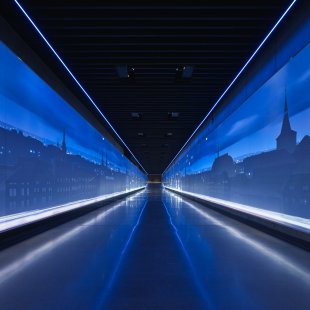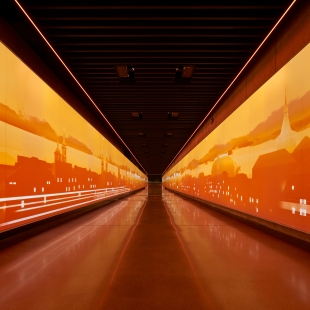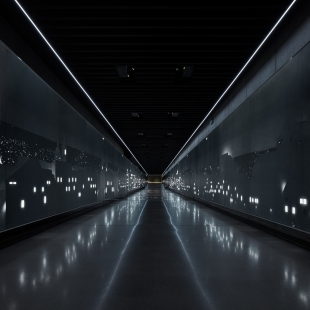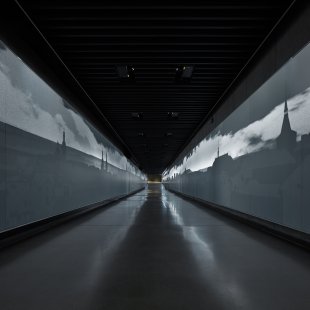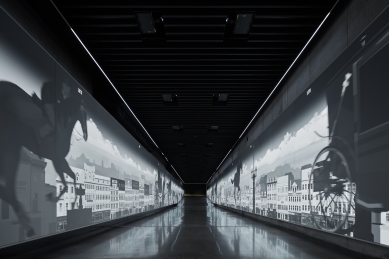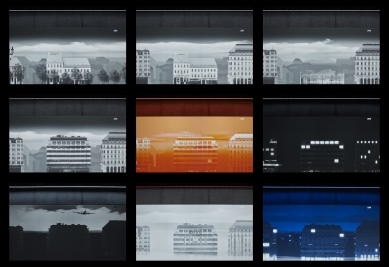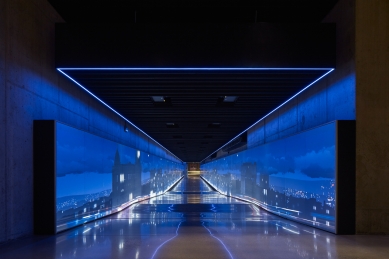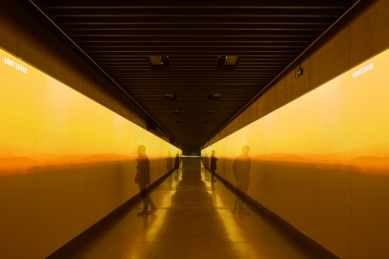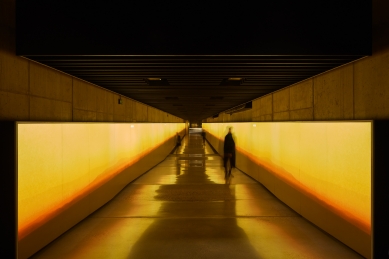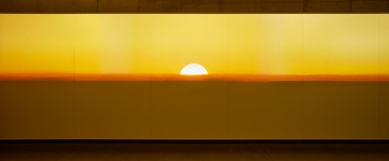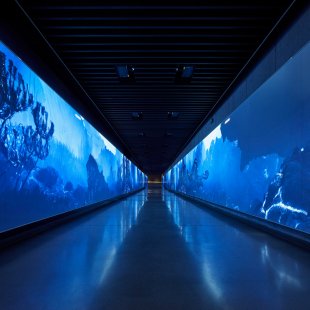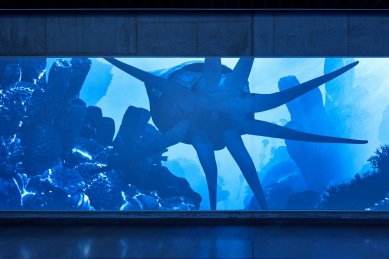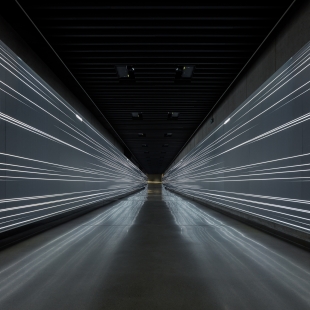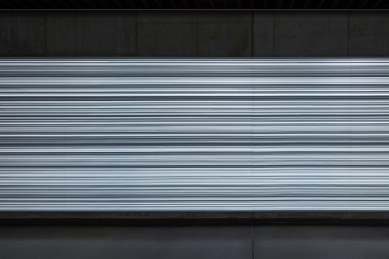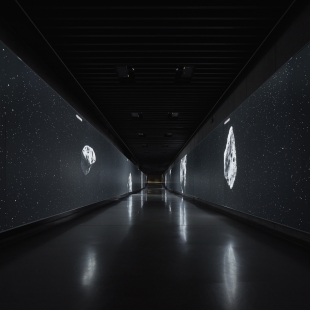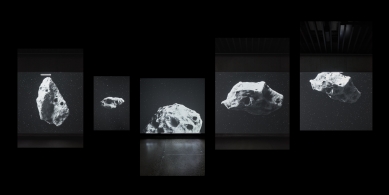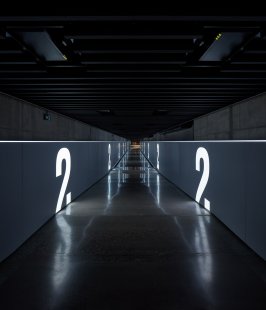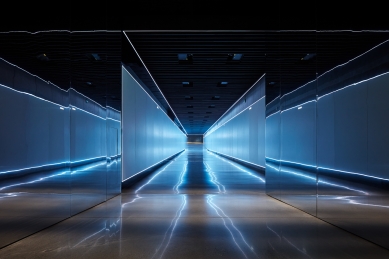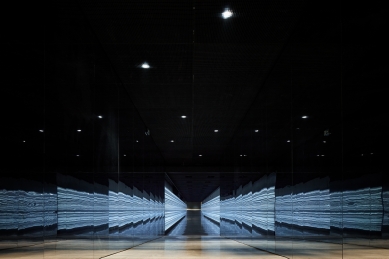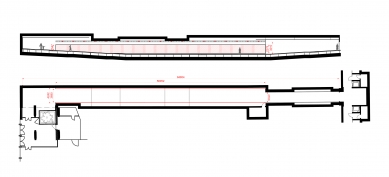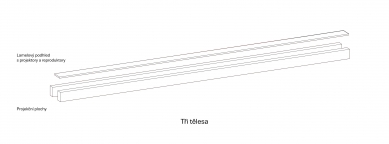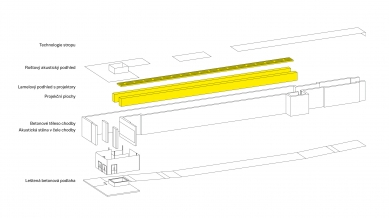
Moments of History / Corridor of Time
Multimedia exhibition in the connecting corridor between the Historical and New Buildings of the National Museum

The corridor is a raw concrete shell serving to connect places, transfer information, and organize people. A cast of free underground volume between the city's infrastructure. We insert three bodies, each 56 meters long, which create a space for the transfer of time.
Wenceslas Square. A key public space in the Czech Republic. The site of the most important events. A crossroads of our nation's history. We present the story of history on the blueprint of one century and the story of the development of architecture on two 720 m long facades of the square.
To make this experience sufficiently authentic, it was necessary to combine the most modern audiovisual technology with impressive technical parameters. The corridor, 56 m long, is covered on both sides with a continuous image with an area of nearly 270 m², projected by a total of 38 laser projectors with mirrored ultra-short throw lenses.
With its resolution, this project represents the largest continuous projection in Europe, and is also exceptional on a global scale.
Moments of the birth of a metropolis
The original Gothic square with Renaissance and Baroque houses transformed into a generous boulevard during the 19th and 20th centuries. This became the center of modern Prague. The houses in the square bear witness to this transformation, reflecting the ambitions and styles of their times.
Changes to 60 buildings of today's square are documented in time-lapse animation. One second of projection equals one real year. Between 1860 and 1939, 66 buildings change, while from 1939 to 2019 only fourteen.
In 1875, trees are planted. However, they are subsequently cut down and then replanted again. Gas lamps are replaced by Křižík's electric lamps on the eve of electrification. These are later replaced by neon facades. The darkness of war bombing transitions into the illumination of communist banners and further into the current smog of LED nights. While in the 1930s the windows of residential buildings shone with life, today they remain dark and only the shop windows glow.
In the prologue of the film, the visitor will see what existed in the space of Wenceslas Square during the primordial seas or at the very beginning of the universe.
Moments of 20th-century history
In this part, the visitor returns from the turn of the millennium to the euphoria of the 1989 revolution. Then he finds himself in the midst of empty rituals of normalization. Another turning point is the occupation of 1968. In the 1950s, the space is full of celebrations of communist totality. Shortly before the onset of communism, people are standing in the square, forced to express loyalty under Nazi rule. All of this is preceded by sincere faith in the Czechoslovak Republic after 1918.
Materials recorded in Wenceslas Square are displayed as museum exhibits.
Each of the themes is represented by a band of eight situations that repeat across events. They are divided into two categories: actions and reactions. The action consists of shots of symbols, driving forces, and situations. The reaction contains shots of individuals and crowds.
Wenceslas Square. A key public space in the Czech Republic. The site of the most important events. A crossroads of our nation's history. We present the story of history on the blueprint of one century and the story of the development of architecture on two 720 m long facades of the square.
To make this experience sufficiently authentic, it was necessary to combine the most modern audiovisual technology with impressive technical parameters. The corridor, 56 m long, is covered on both sides with a continuous image with an area of nearly 270 m², projected by a total of 38 laser projectors with mirrored ultra-short throw lenses.
With its resolution, this project represents the largest continuous projection in Europe, and is also exceptional on a global scale.
Moments of the birth of a metropolis
The original Gothic square with Renaissance and Baroque houses transformed into a generous boulevard during the 19th and 20th centuries. This became the center of modern Prague. The houses in the square bear witness to this transformation, reflecting the ambitions and styles of their times.
Changes to 60 buildings of today's square are documented in time-lapse animation. One second of projection equals one real year. Between 1860 and 1939, 66 buildings change, while from 1939 to 2019 only fourteen.
In 1875, trees are planted. However, they are subsequently cut down and then replanted again. Gas lamps are replaced by Křižík's electric lamps on the eve of electrification. These are later replaced by neon facades. The darkness of war bombing transitions into the illumination of communist banners and further into the current smog of LED nights. While in the 1930s the windows of residential buildings shone with life, today they remain dark and only the shop windows glow.
In the prologue of the film, the visitor will see what existed in the space of Wenceslas Square during the primordial seas or at the very beginning of the universe.
Moments of 20th-century history
In this part, the visitor returns from the turn of the millennium to the euphoria of the 1989 revolution. Then he finds himself in the midst of empty rituals of normalization. Another turning point is the occupation of 1968. In the 1950s, the space is full of celebrations of communist totality. Shortly before the onset of communism, people are standing in the square, forced to express loyalty under Nazi rule. All of this is preceded by sincere faith in the Czechoslovak Republic after 1918.
Materials recorded in Wenceslas Square are displayed as museum exhibits.
Each of the themes is represented by a band of eight situations that repeat across events. They are divided into two categories: actions and reactions. The action consists of shots of symbols, driving forces, and situations. The reaction contains shots of individuals and crowds.
The English translation is powered by AI tool. Switch to Czech to view the original text source.
0 comments
add comment


